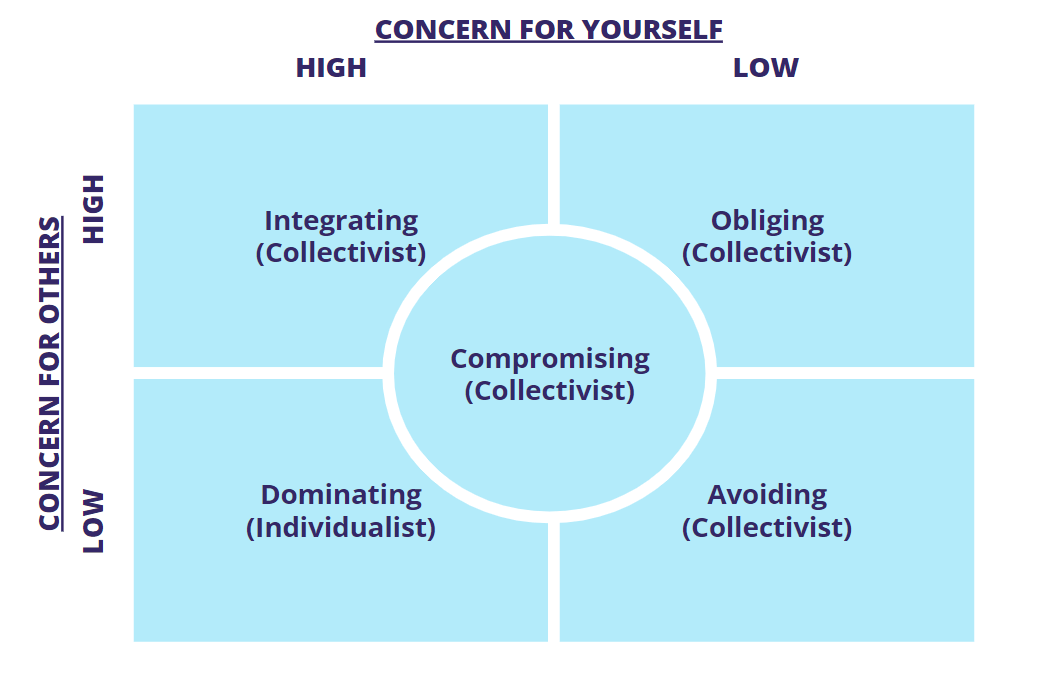ChatGPT & AI in
Procurement Course
Free Preview Lesson

Written by Marijn Overvest | Reviewed by Sjoerd Goedhart | Fact Checked by Ruud Emonds | Our editorial policy
Face Negotiation Theory — 7 Things Every Professional Should Know
Key take-aways
- Face negotiation theory refers to the study of the cultural-general framework of facework negotiation.
- It recognizes the diversity of cultures by having negotiators conduct talks by their cultural backgrounds.
- The face negotiation theory is useful, despite criticism that it oversimplifies cultural differences.
What is the face negotiation theory? Does it have anything to do with how your face looks when negotiating? Or is it a theory where the shape or form of your face has anything to do with the success rate of negotiations?
Whether you take it as a joke or not, the face negotiation theory does exist and for this article, we are going to study it.
After reading this article, you should understand what face negotiation theory is and be able to use it along with your other negotiation skills.
What is the Face Negotiation Theory?
According to Wikipedia, the Face Negotiation Theory is a theory that was conceived by Stella Ting-Toomey in 1985 to understand how people from other cultures are able to manage rapport and disagreements. The reason for the word “face” is because the face is always the first part of the body that other people look at, especially with strangers. Self-image when communicating with others is a very important aspect for every human being when speaking towards others, no matter what their background or culture is.
So in terms of science-speak, face negotiation theory means studying the cultural-general framework of facework negotiation. In plain simple terms, it’s how people negotiate according to where they come from. In order to understand Face Theory better, one should learn more about negotiation styles first.
One good example is the individualist culture in the west. In countries such as the United States, Germany, and Great Britain, there is great value on freedom, personal rights, and the “do-it-yourself” attitude among negotiators. In countries such as Japan, China, Saudi Arabia, and other smaller nations, there is more value in the power of “we” instead of “I”. This is why you’ll see a group of negotiators coming together when dealing with companies that work in Asia and Latin America.
Cultural norms also affect how formal and structured negotiations are. In places like Saudi Arabia, respect for authority and formal interactions are highly valued, while in some Latin American countries, negotiations can be more relaxed and flexible.
Additionally, cultural differences impact how negotiators deal with conflict and express emotions during negotiations. In some cultures, openly disagreeing may be seen as impolite, while in others, it may be seen as honest and upfront.
Being aware of these cultural differences is essential in cross-cultural negotiations to avoid misunderstandings and build trust. Successful negotiators must adjust their approach and communication style to match the cultural norms of the other party. This helps build a good relationship and increases the chances of reaching mutually beneficial agreements.
Face Movements in the Face Negotiation Theory
Face movement refers to options that a negotiator has to face when choosing whether to defend, maintain, and/or upgrade self-face against other-face during a conflict in negotiations. There are four opportunities that a mediator can use in regards to their concern for self-face or their personal image against the other-face or their counterpart’s image of themselves:
-
If there is a low level of concern for both self-face and other-face, the result is mutual-face obliteration.
-
If there is a high level of concern for both self-face and other-face, the result is mutual-face protection.
-
If there is a high level of concern for the other-face, but a low level of concern for the self-face, the result is other-face defense.
-
If there is a high level of concern for the self-face, but a low level of concern for the other-face, then the result is self-face defense.
While these opportunities are set in stone, there will be times when you’ll need to modify, especially if you’re going to work with people with different cultural standards. In a collectivistic culture where the mutual-face concern is very important, avoidance of conflict usually prevails in order for the situation to be defused. Of course, the opposite can be said about an office that works in an individualistic culture.

The 7 Different Conflict Communication Styles That You Should Know
During face negotiations, conflict communication becomes very important. Conflict style consists of learned behaviors that are developed through socialization with one’s culture. The purpose for the development of conflict communication style is to help the negotiator in saving their face and that of the face of the other.
So in this section, you are going to determine what is your own style of conflict communication. It’s important to do so since in negotiations, there will come a time where you’ll need to use conflict communication to resolve issues. Also, if you determine what is your own conflict communication style, you can grow this until you’re confident enough to use it in most negotiations.
There are different conflict communication styles that you can use:
1. Dominating
A conflict communication style puts great emphasis on one person’s position or goal above the other. The dominating style, also called aggressive communication, focuses on one person’s goals and winning, even at the expense of others. It involves intimidating, threatening, and bullying to get what they want. This approach leads to uncooperative, defensive, and hurt responses from others, creating conflict and unhealthy relationships. Aggressive communication can lead to physical and verbal violence and makes it difficult for others to express their concerns or problems due to fear.
2. Avoiding
This style puts an emphasis on eluding the conflict topic, the conflict party, or the conflict situation altogether. Individuals using this style may choose to ignore the issues at hand, withdraw from the discussion, or delay addressing the problem. They often prioritize maintaining peace and harmony over confronting the conflict.
This style can be effective in certain situations where emotions are running high, and a temporary cooling-off period is needed. However, if avoidance becomes a habitual response, it can lead to unresolved issues and escalate the conflict in the long run.
3. Obliging
This conflict style prioritizes the other person’s interests over one’s own. Individuals using this communication style tend to prioritize the needs of others, considering them more important than their own.
They may feel inferior and struggle in their relationships with colleagues and friends. Being submissive and acting as a doormat can harm their self-esteem. People with this style often avoid confrontation and apologize excessively. They yield to others’ preferences and have difficulty expressing their own feelings and desires.
4. Integrating
Integrating is a conflict style where both parties work together to find a solution that meets the needs and concerns of each person.
It involves making concessions or compromises to reach a mutual agreement. The focus is on addressing the interests of both sides to achieve a win-win outcome.
5. Emotional Expression
Emotional expression is a conflict style where individuals openly share their feelings and emotions when dealing with conflicts.
By expressing emotions, they try to better understand their own reactions and manage the conflict effectively. It helps them gain control over their emotions and find ways to resolve the issues constructively.
6. Third-Party Help
This is a conflict communication style that involves seeking assistance from an outside person or mediator to resolve the conflict.
This third party acts as a neutral facilitator, helping the parties involved communicate effectively and find common ground for resolving their differences. The goal is to manage communication and find a fair resolution with the help of an impartial mediator.
7. Passive Aggressive
This conflict style involves indirectly reacting to conflicts, blaming others without confronting them directly. It’s an approach where people act out anger in subtle ways or behind the scenes. It’s often used by those who feel powerless and resentful.
They may undermine others and sabotage themselves to express their feelings. This style includes gossip, pretense, and being two-faced. People on the receiving end feel hurt, angry, and may lose trust. While it may achieve short-term results, it causes lasting damage to relationships and makes it hard for others to believe their sincerity.
Communication Barriers
Effective communication is a must in negotiation, fostering mutually-beneficial relationships. However, communication barriers can hinder this process. Here are some of the barriers in communication:
1. Cognitive constraint
Cognitive constraints are the most common barrier to communication. These are world views that are based on culture.
This creates a backdrop for comparing new information. For example, some people In the United States may be susceptible to feeling superior to many cultures due to the power of the United States since World War II.
2. Behavior constraint
These are the ways in which people behave in different cultures. Each culture has its unique rules about proper behavior that affects verbal and non-verbal communication.
Behavior constraints can be as simple as eye contact or even how you should be close to somebody. Culture regulates behavior differently.
3. Emotional constraint
Emotional constraints describe the ways culture regulates the display of emotion. It tells how emotional one can get in a situation.
For example, Italians are generally open about their emotions. They hug and kiss people and you can see their emotions transparently. British and Asians on the other hand are reserved and keep their emotions inside them.
Four Faces of Face Negotiation
In negotiation, professionals often adopt different personas, wearing masks that conceal their true intentions. These masks represent the four faces of face negotiation which are the following:
1. Face-saving
Face-saving focuses on the need to signal respect for the other party’s need for space. This face often occurs when there is a need to preserve the relationship between parties, even by hiding information that may be offensive to the other, such as disputes between family members.
2. Face-restoration
This face focuses on the need to be able to protect oneself from the infringement of other people. Usually, this face results in being reluctant to participate in negotiation just to protect their own privacy.
3. Face-giving
In face-giving, the person has the need to protect or defend the other party’s need for inclusion and association. Just like face-saving, it is often seen when there is a need to preserve the relationship between two parties.
People who are operating this face are more willing to bring a neutral party to help with the negotiation that is mutually beneficial for all.
4. Face-assertion
In face-assertion, a person has the need to protect and defend himself/herself for inclusion and association. This is usually done by making themselves look good and possibly making the other party look bad.
Face Negotiation Theory Example
Facework research is studied in different fields like anthropology, psychology, sociology, and more. It helps us understand how people manage their image during conflicts and conversations.
The concept came about because the author was not satisfied with how Western conflict communication was viewed. They wanted to include Eastern cultural ideas. So, they created the face negotiation theory, which has been improved over time. It helps explain how people handle conflicts and maintain their relationships with others.
The following are the core assumptions of the Face Negotiation Theory:
-
People from all cultures care about how they appear and handle communication in different situations.
-
The concept of face is especially important when emotions are involved or when people feel vulnerable about their identity.
-
Cultural differences, like how much individuals focus on themselves or the group, and how much they respect authority, influence how people handle their image in communication.
-
Some people prioritize their own image, while others care more about others’ feelings.
-
Cultural values also affect whether people prefer informal or formal ways of managing their image in interactions.
-
Cultural values, along with personal, relational, and situational factors, shape how people manage their image during conflicts.
-
Intercultural facework competence means being sensitive to different cultures, mindful of others’ feelings, and able to adapt communication to handle identity-related conflicts effectively.
Now, let’s dive into this example:
People in Western countries have a different way of reacting to conflicts in comparison to those people in Eastern countries. Somehow, people from Western countries are more individualistic while those in Eastern countries have a more collectivist culture.
Different cultures can have different interpretations of various things such as eye contact as a sign of respect or rudeness. In some Western cultures, eye contact is a sign as a good gesture of attention. However, eye contact can be interpreted as rude in Eastern countries.
Thus, the face negotiation theory helps you understand how people from different cultures communicate which will allow you to discuss with them without being misunderstood. Additionally, knowing their cultural background will enable you to control the negotiation without disrespecting their culture.
Criticism of Face Negotiation Theory
In Western countries, people often emphasize personal achievements and responsibility, while Eastern countries value community and cooperation. However, there are exceptions, as some societies in both regions may follow different cultural norms.
Critics of the face negotiation theory argue that it oversimplifies cultural differences and ignores individual variations. They say it might perpetuate stereotypes and not consider power dynamics and other influences on communication.
Despite criticism, the face negotiation theory remains helpful in understanding how culture affects communication and negotiation. However, it’s essential to avoid generalizations and consider individual and situational factors in cross-cultural interactions.
Conclusion
Coined by Stella Ting-Toomey in 1985, to sum it up, the Face Negotiation Theory is how people negotiate according to where they are from. For example, negotiators from the US value freedom and personal rights and incorporate that in their negotiation strategies. It also goes the same for negotiators from Japan and China who value teamwork and usually work in groups.
Moreover, there are four opportunities that a negotiator can use when doing the Face Negotiation Theory. Although these opportunities are not interchangeable, there will be times you must modify them, especially when there are other people with different cultural standards.
With that, due to the diversity, there are risks of communication barriers that can hinder a successful negotiation process. So, you must take note of them in case it happens.
Furthermore, the Face Negotiation Theory is a huge opportunity to mask oneself and put on personas that are advantageous for negotiating. Thus, you must be able to determine whether the person you are negotiating with uses one of these so that you would not be tricked or intimidated. With that, you’ll be able to negotiate for the best values with great benefits!
Frequentlyasked questions
What is face negotiation theory?
Face negotiation theory is the theory of conducting negotiations through the study of one’s cultural background in negotiations and discussions.
What is a face negotiation theory example?
A famous example of a face negotiation theory is the Chinese negotiation style of saving face.
How to deal with the face negotiation theory?
Dealing with face negotiation can be done by studying the traditions and culture of how certain countries do their negotiations.
About the author
My name is Marijn Overvest, I’m the founder of Procurement Tactics. I have a deep passion for procurement, and I’ve upskilled over 200 procurement teams from all over the world. When I’m not working, I love running and cycling.


